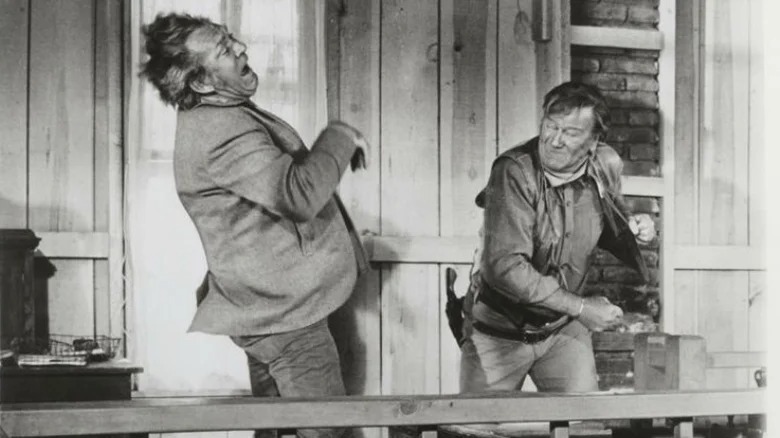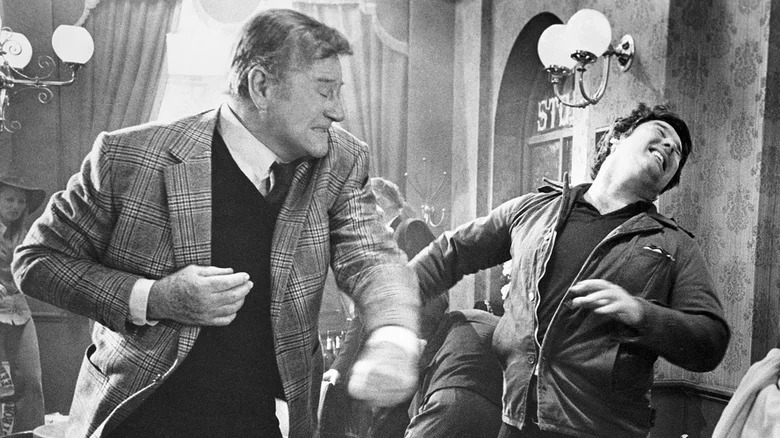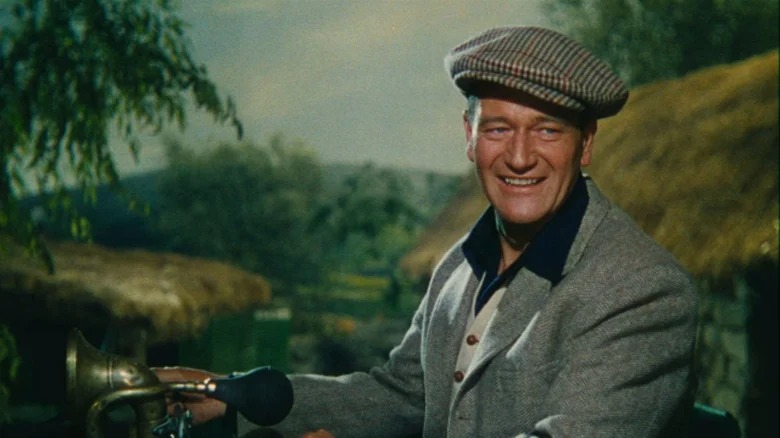Before John Wayne began making low-budget Westerns in the 1930s, stunt performers were rarely, if ever, acknowledged or given credit for their work. Studios didn’t want to break the illusion to reveal that it wasn’t the main star on-screen performing their own stunts, so the practice became one of Hollywood’s biggest secrets. Looking back on the history of stunts from the era, the British Action Academy noted that, during that time, studios and directors began demanding more dangerous stunts that resulted in a large increase in on-set fatalities.
The marquee star wasn’t in mortal jeopardy and some actors like Harold Lloyd had it written into their contracts that it could never be revealed when a stuntman was utilized. Tom Mix, the first bonafide movie star, always claimed that he was the one who made the famous horse jump across the Beale’s Cut ravine in John Ford’s 1923 short film, “3 Jumps Ahead.” However, Mix biographer Robert S. Birchard, author of “King Cowboy: Tom Mix and the Movies,” insisted that it was actually a stuntman and horse trainer named Earl Simpson.
Up until the era of John Wayne, there was always a clear delineation between actor and stuntman. Once talkies became mainstream, the Western remained popular but the genre was relegated to B-movie status. After the failure of his first starring role in “The Big Trail,” Wayne took an interest in learning more about stunt work, becoming proficient in horse riding and the general cowboying skills needed to look the part on-screen. Over the next decade, Wayne would hone his skills and become fast friends with the legendary stuntmen Yakima Canutt. In the years ahead, Wayne would help usher in an entirely new approach to fight choreography that proved safer for performers and more realistic to audiences.
Acting like a real-life street fighter

Warner Bros.Most of John Wayne’s greatest movie moments involve punching something or someone. The sound of his punch alone echoed throughout movie halls and became a famous signature of his. Since the actors weren’t really punching each other, the sound of the hit would be added later in post and it always seemed like the hero’s punch was always a little louder. Back when the action star began his career, however, the actors really were making contact. “At that time, in pictures, the way they did a fight was, you and your opponent, you hit each other in the shoulders and faked it to look like real,” Wayne said in an interview in author Maurice Zolotow’s biography “Shooting Star.” Wanting the fights to be as realistic as possible, Wayne emulated world heavyweight champion Jack Dempsey, studying old newsreels of Dempsey training before a bout.
Unfortunately for performers like Yak Canutt, someone who found himself on the other end of those punches on more than one occasion, Wayne’s commitment to authenticity resulted in some real abuse. “I wouldn’t hold back when I felt myself gettin’ all worked up with hatred for a villain,” Wayne recalled. “I wanted to kill the son-of-a-b****. Matter of fact, I guess I liked these fight scenes more than any other stunts we did.”
Canutt went on to perform incredibly dangerous, spectacular stunts in “Stagecoach” and “Zorro’s Fighting Legion,” but he went up against John Wayne’s fists first. Complaints from Canutt and a little ingenuity from director Robert Bradbury (“West of the Divide,” “Westward Ho”) wound up leading to a completely new way to shoot a fight scene, with a technique still used today.
Inventing a new camera trick

United ArtistsInstead of punching the daylights out of his co-stars until they were black and blue, John Wayne described the day when director Robert Bradbury, one of Wayne’s early cohorts and collaborators, had a moment of inspiration. As told in the “Shooting Star” biography:
“[Bradbury] said that he thought if he placed the camera at a certain angle it would look as if my fist was making contact with Yak’s face, though my fist was passing by his face, not even grazing it. We tried it out one day, and when we saw the rushes we saw how good it looked. Bradbury invented this trick, which he called the pass system. Other stuntmen and directors picked up on it, and it became the established way of doing a fight.”
Before this simple but brilliant idea of the pass system was invented, there just wasn’t a lot of thought paid to protecting actors and efforts to make movie sets a little safer were still in early stages of development. Something as basic as changing the angle of the shot immediately lessened the blows performers were taking without compromising a fight scene’s believability. Wayne loved it because he could still pack just as much power into his punches. In the famous fight against Vic McLagen in “The Quiet Man,” Wayne played a retired American prizefighter for the first time. Watching the brawl, it’s clear both actors aren’t holding anything back but, miraculously, they never made physical contact once.
For a heavy like John Wayne who loved a good battle, the new technique was a welcome tool in his arsenal that allowed him to keep punching for years to come, in films such as 1975’s “Brannigan.” “I had plenty of fights on-screen. I’ve been told I’ve done more fighting in pictures than any other star –- and I’ve also had a few fights off the screen.”


 Entertainment10 months ago
Entertainment10 months ago
 Entertainment10 months ago
Entertainment10 months ago
 Entertainment11 months ago
Entertainment11 months ago
 Entertainment1 year ago
Entertainment1 year ago
 Entertainment10 months ago
Entertainment10 months ago
 Entertainment11 months ago
Entertainment11 months ago
 Entertainment11 months ago
Entertainment11 months ago
 Entertainment10 months ago
Entertainment10 months ago

 United ArtistsInstead of punching the daylights out of his co-stars until they were black and blue, John Wayne described the day when director Robert Bradbury, one of Wayne’s early cohorts and collaborators, had a moment of inspiration. As told in the “Shooting Star” biography:
United ArtistsInstead of punching the daylights out of his co-stars until they were black and blue, John Wayne described the day when director Robert Bradbury, one of Wayne’s early cohorts and collaborators, had a moment of inspiration. As told in the “Shooting Star” biography:







